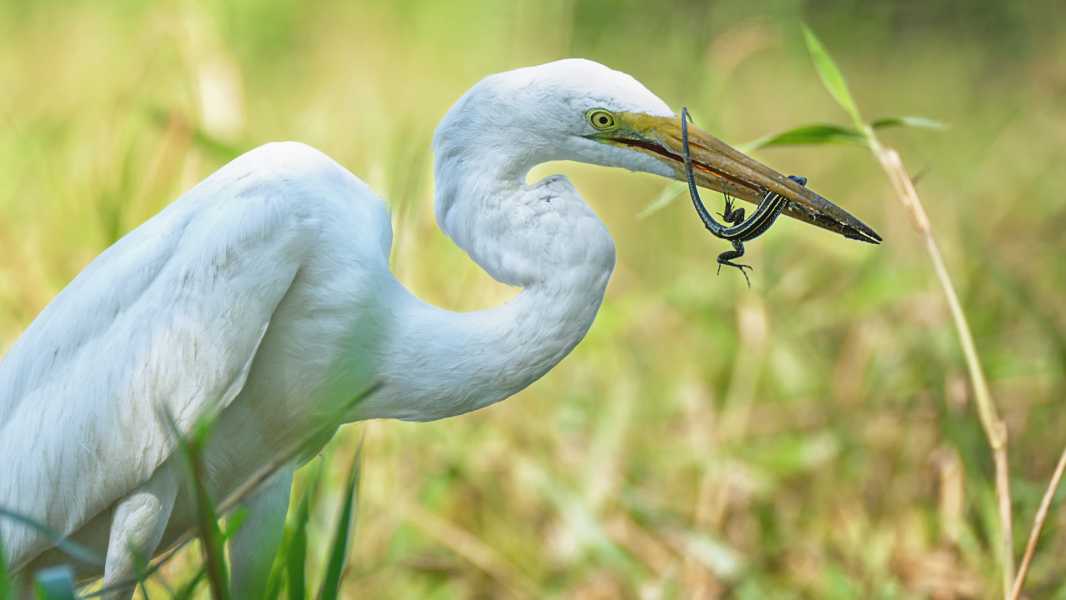
Are birds like this large white heron actually reptiles? (Photo credit: Chrissia Campos via Getty Images)
Anyone who has ever noticed a rooster stalking around a farmyard might think that there is something very dinosaur-like about birds. This is not surprising, considering that birds are descendants of dinosaurs. But from a taxonomic standpoint, this raises a question: since dinosaurs are reptiles, does that mean that birds are also reptiles?
“I would say that all modern biologists would agree, or should agree, that birds are reptiles,” Martin Sturvander, an evolutionary biologist and senior curator of birds at the National Museum of Scotland, told Live Science.
However, this was not always the case. Until the 1940s, biologists used a system known as the Linnaean method to classify all life on Earth. This approach was developed by Carl Linnaeus in the 1730s and relies on grouping animals that share similar physical traits. Linnaeus determined that all reptiles share two main characteristics: they have scales, and they are ectothermic, or “cold-blooded,” meaning they rely on external heat sources to maintain their body temperature.
Because warm-blooded, feathered birds lack these characteristics, “birds were considered a separate branch on the tree of life” in Linnaeus’s system, said Clara Widrig, a research associate in the department of vertebrate zoology at the Smithsonian Institution’s National Museum of Natural History in Washington, D.C. While Linnaeus’s classification accurately reflects many relationships and helped establish the major branches of the tree of life we use today, it leaves out something that can reveal far more about an organism: its genetics.
Since the 1940s, the ability to study genetic material has led to a new type of classification called phylogeny. The phylogenetic method groups or separates organisms based on the degree to which their DNA is similar. It also allows scientists to compare the DNA of different organisms to trace their evolutionary history and identify common ancestors.
Phylogeny of birds
In this system, organisms are classified into “clades,” which are distinct branches on the phylogenetic tree that include all descendants of the most recent common ancestor. For example, modern birds are grouped into the Neornithes clade, since they all descended from a common ancestor of Neornithines that lived 80 million years ago, before the non-avian dinosaurs went extinct. “Clades are a nested hierarchy,” Widrig explained. So, “as you move further up the tree of life, you’ll find that [Neornithes] also belong to the broader clade Theropoda,” a group of bipedal, mostly carnivorous dinosaurs that itself evolved from the Dinosauria clade.
Even in the age of dinosaurs, the characteristics of scaly reptiles and birds were not so clearly distinguishable. Research shows that some dinosaurs were warm-blooded, and some non-avian dinosaurs had feathers. Meanwhile, it has since become known that birds that looked like modern ones already existed on Earth alongside other dinosaurs 66 million years ago. One such example is the “miracle chicken” (Asteriornis), a fossil described in 2020 by a research team that included Widrig. “Imagine if I used a time machine to pick up Asteriornis and go back with it, everyone would say, ‘Oh yeah, that’s just a regular bird.’”
But back to the tree of life: Birds' descent from theropods and dinosaurs makes them dinosaurs. At the same time, dinosaurs, along with crocodiles and other lineages such as pterosaurs, are part of another clade called archosaurs. This clade, in turn, shares a common ancestor with a group known as lepidosaurs, which became the ancestors of
Sourse: www.livescience.com





